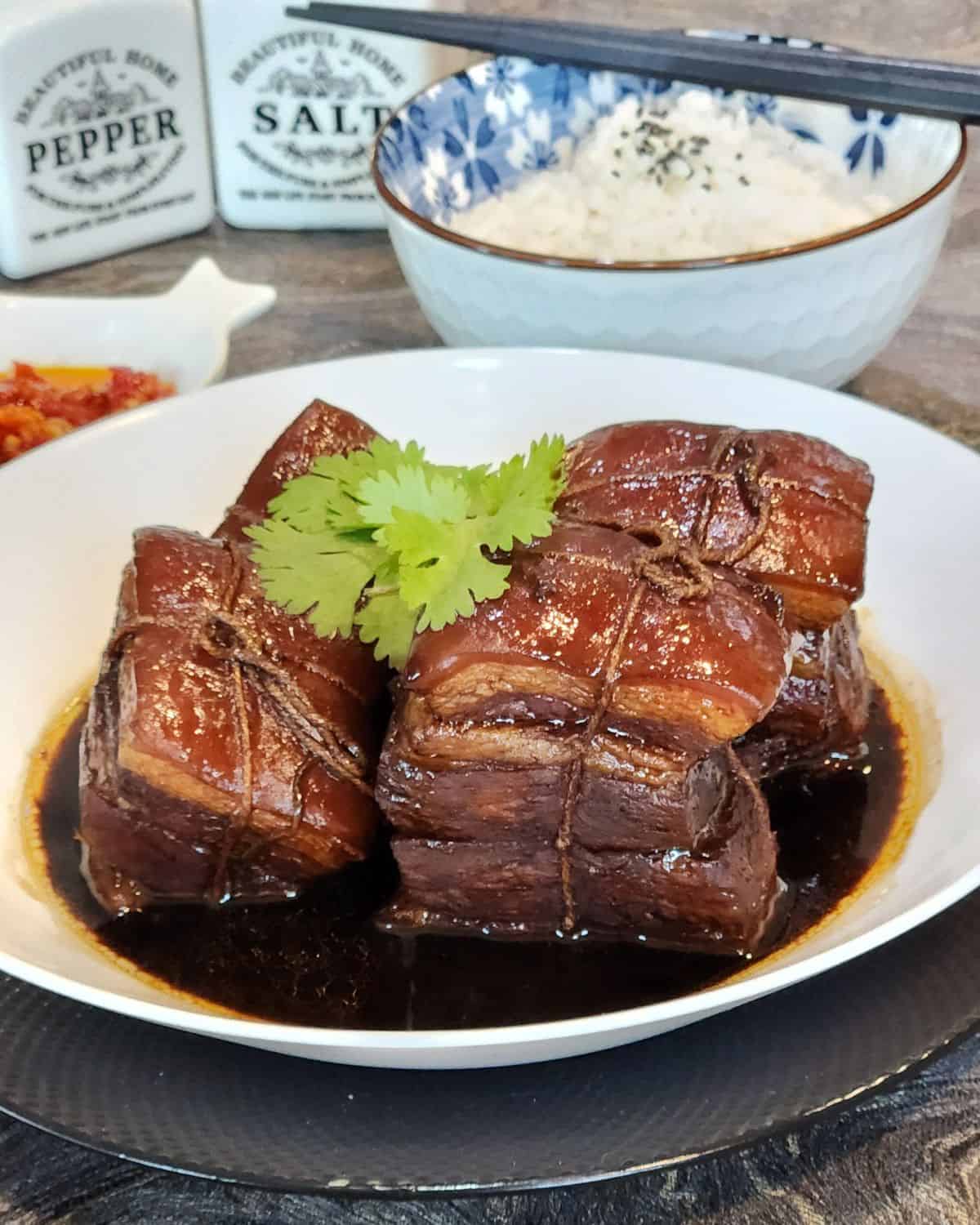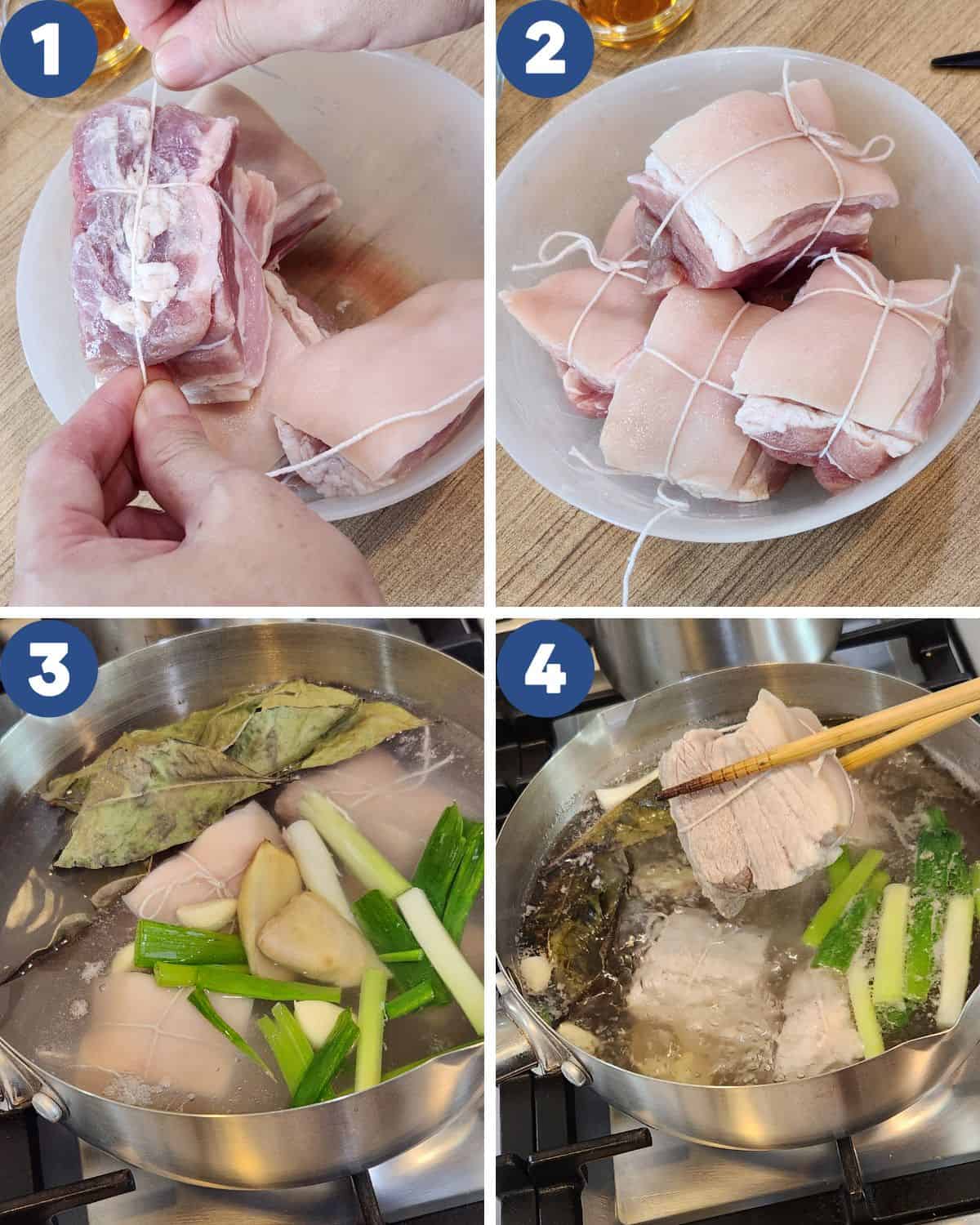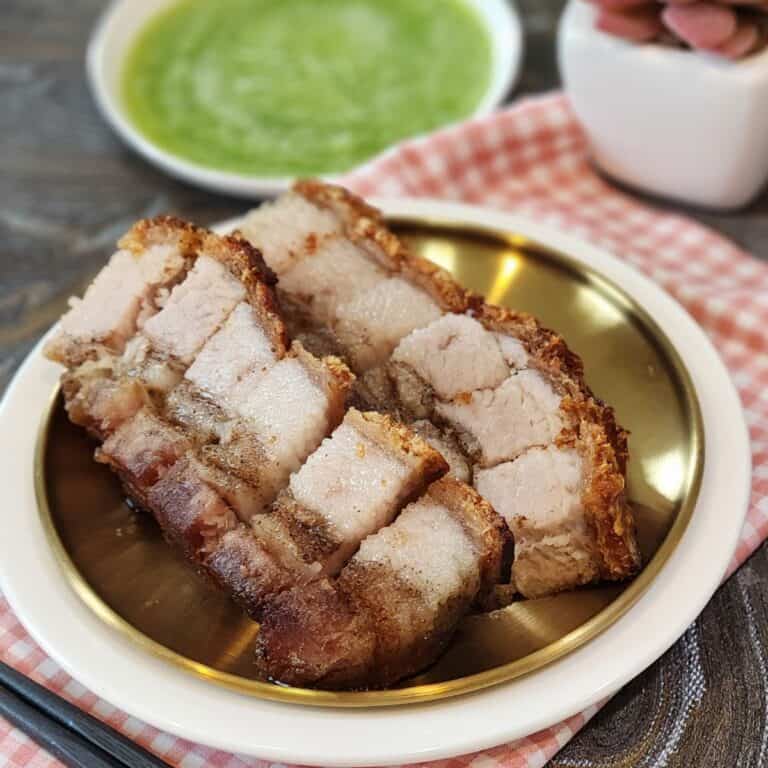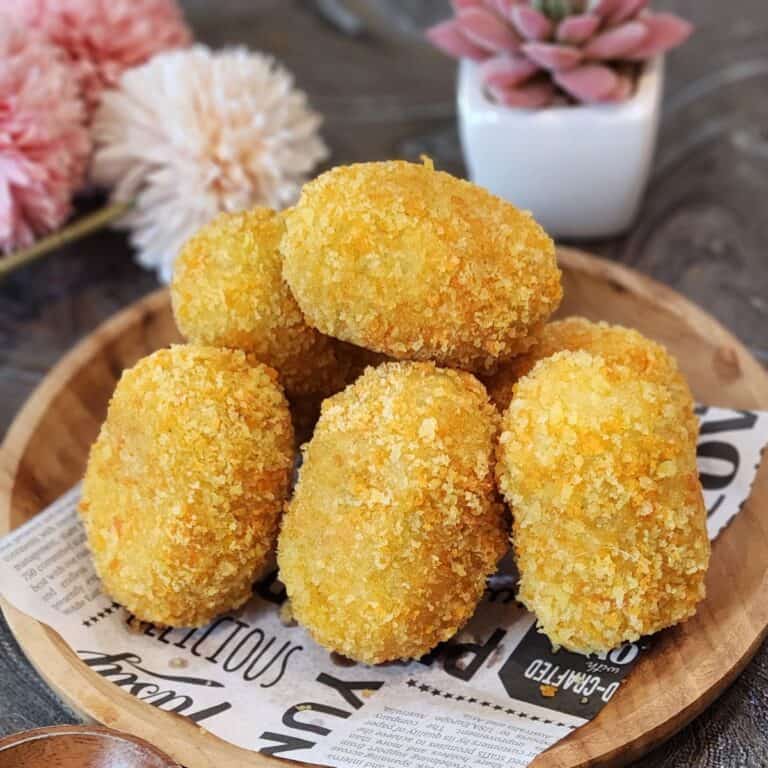Chinese Braised Pork Belly – Dong Po Rou
Dong Po Rou isn’t just pork belly—it’s a Chinese culinary masterpiece. Braised low and slow, this dish delivers fork-tender bites wrapped in layers of rich, aromatic flavor – one taste, and you’ll understand why this dish is pure comfort food magic.

Dong Po Rou (東坡肉) is one of those Chinese dishes that feels like a warm hug in food form. Originating from the Jiangsu and Zhejiang provinces, this pork belly dish—with its five luxurious layers of meat and fat—was first popularized by Su Dong Po, the beloved poet and foodie from the Song dynasty. The meat is braised low and slow in soy sauce, Shaoxing wine, and aromatic spices until every layer turns meltingly tender.
Unlike the crackling crunch of crispy roast pork belly or the glossy sweet char siu, Dong Po Rou is all about quiet elegance. Its rich, savory-sweet sauce soaks deep into the pork, making it the kind of dish you savor with a simple bowl of rice or fluffy mantou buns.
Even compared to the smoky pork jerky, Dong Po Rou is comfort food on a whole different level. Together, these dishes will complete your family dinner in a different way.
Why You Will Love This Recipe
Recipe Ingredients

Ingredient Notes
Pork Belly – The star of this dish! Choose a good piece of pork belly with five distinct layers of skin, fat, and meat—known in Chinese as (五花肉) wu hua rou. A square cut with an even top and bottom will cook and present beautifully.
Chinese Claypot – A claypot adds a touch of authenticity and holds heat well, but don’t worry if you don’t have one—a regular heavy-bottomed pot will work just fine.
Cotton Strings – Optional but helpful. Tying the pork belly keeps it firm and prevents it from falling apart during long hours of braising.
Golden Syrup / Rock Sugar – Golden syrup adds a beautiful caramelized depth to the sauce. You can make your own easily (check out my homemade golden syrup recipe), or substitute with palm sugar or brown sugar.
Be sure to check out the full recipe and ingredient list below
How to Make Dong Po Rou

STEP 1. Cut the pork belly into squares (keep in mind they’ll shrink when cooked). Tie each piece with cotton string to keep it firm during braising (Images 1, 2). Place in a pot with enough cold water to cover, then add scallions, leeks, ginger slices, and bay leaves (Images 3, 4). Bring to a boil over medium heat and simmer for 10 minutes to remove impurities. Skim off any white foam.

STEP 2. Remove the pork belly and pat it dry. In a dry skillet, sear each side to render excess fat (Images 5, 6). This step keeps the final dish less greasy. In a clean pot, lay scallions, ginger, garlic, star anise, and dried chilies (if using) at the bottom (Images 7, 8). Place the pork belly on top.

STEP 3. Pour in white cooking wine, Shaoxing wine, dark soy sauce, golden syrup, and enough water to fully cover the pork (Images 9–11). Cover with a lid and bring to a boil over medium heat (Image 12).

STEP 4. Once boiling, lower the heat. Simmer for 1 ½ hours, turning the pork occasionally (Image 13). When the liquid has reduced and the pork is dark brown (Image 14), uncover and cook for another 30 minutes to thicken the sauce. Strain the broth and discard the aromatics (Image 15). Remove the ties and serve the pork belly with the sauce, warm rice, or steamed buns (Image 16).
Pro Tips
- Authenticity – Use a claypot for a traditional touch, but a heavy-bottomed pot works just as well.
- Make your pork belly fragrant – Blanch the pork belly in boiling water for 10 minutes to remove impurities and odor.
- Less oily – Sear each side of the pork to render excess fat, keeping the final dish light and glossy.
- Note the size – Cut the pork belly slightly larger than you want it served, as it will shrink during cooking.
- Make ahead – The flavor only gets better after resting overnight, perfect for meal prep or hosting.
- Golden touch – Use homemade golden syrup for a richer, caramelized sauce.
How to Serve
Dong Po Rou is best enjoyed with a simple bowl of steamed rice or soft, pillowy mantou buns, try my Pumpkin Mantou or Cheese Mantou for an extra treat. The rich, savory sauce soaks beautifully into the bread, making every bite pure comfort.
Round out your meal with a few side dishes like stir-fried green beans with eggs, a fiery Sichuan-style tofu, or a comforting bowl of egg drop soup. A light pork and broccoli stir-fry also pairs well, balancing out the deep flavors of the braised pork belly.
FAQs about Dong Po Rou
Dong Po Rou is a specific style of red-braised pork named after the Song dynasty poet Su Dong Po. It is simmered in wine, soy sauce, and sugar for a longer time than Hong Shao Rou, resulting in deeper caramelization, a more gelatinous texture, and an intensely savory-sweet glaze.
You know it’s ready when the pork belly becomes tender enough to slide a chopstick through easily, and the sauce has thickened into a shiny glaze that clings to the meat.
Yes! Many home cooks successfully adapt traditional recipes for the slow cooker or Instant Pot—just adjust cooking time and liquid levels accordingly. The slow method can actually enhance tenderness and flavor concentration.
Opt for skin-on pork belly with even layers of fat and lean meat. Cubes around 5 cm (2 in) ensure the best balance of texture and flavor—and note that the pieces will shrink during braising, so cut generously.

Storage
Store leftover pork in an airtight container in the fridge for up to 3–4 days. The flavors deepen after resting—serve shredded in steamed buns, fried rice, or spoon over rice. It’s even better the next day

Dong Po Rou
Equipment
- 1 claypot optional
Ingredients
- 1 kg pork belly
- 600 cc white cooking wine
- 2 tbsp shao xing wine
- 5 tbsp dark soy sauce
- 2 tbsp golden syrup or rock sugar
- 1000 cc Water
- 2 slices Ginger
- 1 stalk Leeks/scallions
- 6 pcs Garlic
- 1 Star anise
- 2 pcs Bay leaf
Instructions
- Cut the pork belly into squares (keep in mind they’ll shrink when cooked). Tie each piece with cotton string to keep it firm during braising. Place in a pot with enough cold water to cover, then add scallions, leeks, ginger slices, and bay leaves. Bring to a boil over medium heat and simmer for 10 minutes to remove impurities. Skim off any white foam.
- Remove the pork belly and pat it dry. In a dry skillet, sear each side to render excess fat. This step keeps the final dish less greasy. In a clean pot, lay scallions, ginger, garlic, star anise, and dried chilies (if using) at the bottom. Place the pork belly on top.
- Pour in white cooking wine, Shaoxing wine, dark soy sauce, golden syrup, and enough water to fully cover the pork. Cover with a lid and bring to a boil over medium heat.
- Once boiling, lower the heat. Simmer for 1 ½ hours, turning the pork occasionally. When the liquid has reduced and the pork is dark brown, uncover and cook for another 30 minutes to thicken the sauce. Strain the broth and discard the aromatics. Remove the ties and serve the pork belly with the sauce, warm rice, or steamed buns.
Video
Notes
- Authenticity – Use a claypot for a traditional touch, but a heavy-bottomed pot works just as well.
- Make your pork belly fragrant – Blanch the pork belly in boiling water for 10 minutes to remove impurities and odor.
- Less oily – Sear each side of the pork to render excess fat, keeping the final dish light and glossy.
- Note the size – Cut the pork belly slightly larger than you want it served, as it will shrink during cooking.
- Make ahead – The flavor only gets better after resting overnight, perfect for meal prep or hosting.
- Golden touch – Use homemade golden syrup for a richer, caramelized sauce.










I was challenged by my husband to make this ancient Chinese dish created by a famous poet in China. It turned out super delicious and everyone in the family loves it. The meat is so tender and the broth so tasty!